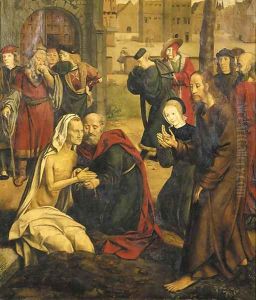Jan Joest Van Calcar Paintings
Jan Joest van Calcar, also known as Jan Joest or Jan Joest van Kalkar, was a Netherlandish painter who was active during the late 15th and early 16th centuries. He is primarily known for his religious works and his contributions to the Northern Renaissance. Although there is limited documentation about his life, it is believed that Jan Joest was born in the 1450s in the town of Calcar, which is now in modern-day Germany near the Dutch border.
Jan Joest's artistic training and early career remain largely obscure due to the lack of records. However, he is thought to have been influenced by the works of contemporary Dutch and Flemish painters, incorporating their attention to detail and realism into his own style. He is best known for his altarpiece in the church of St. Nicholas in the town of Kalkar, Germany. This work, completed around 1505-1508, is considered his masterpiece and is notable for its intricate detail and use of color.
The altarpiece contains a series of panels depicting scenes from the life of Christ. Jan Joest's work on this project showcases his exceptional ability to portray narrative and emotion, as well as his skillful use of light and shadow to create a sense of depth and volume. His figures are rendered with a high degree of individuality and expressiveness, which was a significant contribution to the evolving style of the period.
Little is known about Jan Joest's other works, as few have been attributed to him with certainty. However, his influence was felt through his detailed and emotive approach to painting, which would have been seen by other artists of the time. He is sometimes connected to the Haarlem school of painting, and some art historians speculate he may have had a connection to the young Albrecht Dürer, who traveled to the Low Countries around the same period.
Jan Joest van Calcar died in 1519. While not as widely recognized as some of his contemporaries, his work remains an important example of the Northern Renaissance, and his altarpiece in Kalkar continues to be admired for its artistic merit and historical significance.
